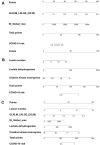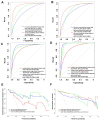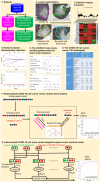A COVID-19 risk score combining chest CT radiomics and clinical characteristics to differentiate COVID-19 pneumonia from other viral pneumonias
- PMID: 33713401
- PMCID: PMC8064216
- DOI: 10.18632/aging.202735
A COVID-19 risk score combining chest CT radiomics and clinical characteristics to differentiate COVID-19 pneumonia from other viral pneumonias
Abstract
With the continued transmission of severe acute respiratory syndrome coronavirus 2 (SARS-CoV-2) throughout the world, identification of highly suspected COVID-19 patients remains an urgent priority. In this study, we developed and validated COVID-19 risk scores to identify patients with COVID-19. In this study, for patient-wise analysis, three signatures, including the risk score using radiomic features only, the risk score using clinical factors only, and the risk score combining radiomic features and clinical variables, show an excellent performance in differentiating COVID-19 from other viral-induced pneumonias in the validation set. For lesion-wise analysis, the risk score using three radiomic features only also achieved an excellent AUC value. In contrast, the performance of 130 radiologists based on the chest CT images alone without the clinical characteristics included was moderate as compared to the risk scores developed. The risk scores depicting the correlation of CT radiomics and clinical factors with COVID-19 could be used to accurately identify patients with COVID-19, which would have clinically translatable diagnostic and therapeutic implications from a precision medicine perspective.
Keywords: COVID-19; chest CT; coronavirus disease 2019; nomogram; radiomics; severe acute respiratory syndrome coronavirus 2.
Conflict of interest statement
Figures







Similar articles
-
Diagnostic classification of coronavirus disease 2019 (COVID-19) and other pneumonias using radiomics features in CT chest images.Sci Rep. 2021 Sep 9;11(1):17885. doi: 10.1038/s41598-021-97497-9. Sci Rep. 2021. PMID: 34504246 Free PMC article.
-
CT radiomics facilitates more accurate diagnosis of COVID-19 pneumonia: compared with CO-RADS.J Transl Med. 2021 Jan 7;19(1):29. doi: 10.1186/s12967-020-02692-3. J Transl Med. 2021. PMID: 33413480 Free PMC article.
-
CT-based radiomics combined with signs: a valuable tool to help radiologist discriminate COVID-19 and influenza pneumonia.BMC Med Imaging. 2021 Feb 17;21(1):31. doi: 10.1186/s12880-021-00564-w. BMC Med Imaging. 2021. PMID: 33596844 Free PMC article.
-
Thoracic imaging tests for the diagnosis of COVID-19.Cochrane Database Syst Rev. 2020 Sep 30;9:CD013639. doi: 10.1002/14651858.CD013639.pub2. Cochrane Database Syst Rev. 2020. Update in: Cochrane Database Syst Rev. 2020 Nov 26;11:CD013639. doi: 10.1002/14651858.CD013639.pub3. PMID: 32997361 Updated.
-
Systematic Review and Meta-Analysis on the Value of Chest CT in the Diagnosis of Coronavirus Disease (COVID-19): Sol Scientiae, Illustra Nos.AJR Am J Roentgenol. 2020 Dec;215(6):1342-1350. doi: 10.2214/AJR.20.23391. Epub 2020 Jun 1. AJR Am J Roentgenol. 2020. PMID: 32478562
Cited by
-
A radiomics model utilizing CT for the early detection and diagnosis of severe community-acquired pneumonia.BMC Med Imaging. 2024 Aug 5;24(1):202. doi: 10.1186/s12880-024-01370-w. BMC Med Imaging. 2024. PMID: 39103756 Free PMC article.
-
An Intelligent System for Classifying Patient Complaints Using Machine Learning and Natural Language Processing: Development and Validation Study.J Med Internet Res. 2025 Jan 8;27:e55721. doi: 10.2196/55721. J Med Internet Res. 2025. PMID: 39778195 Free PMC article.
-
Prediction of radiation-induced acute skin toxicity in breast cancer patients using data encapsulation screening and dose-gradient-based multi-region radiomics technique: A multicenter study.Front Oncol. 2022 Nov 10;12:1017435. doi: 10.3389/fonc.2022.1017435. eCollection 2022. Front Oncol. 2022. PMID: 36439515 Free PMC article.
-
Radiomics-Assisted Computed Tomography-Based Analysis to Evaluate Lung Morphology Characteristics after Congenital Diaphragmatic Hernia.J Clin Med. 2023 Dec 15;12(24):7700. doi: 10.3390/jcm12247700. J Clin Med. 2023. PMID: 38137769 Free PMC article.
-
CT-based radiomic nomogram for predicting the severity of patients with COVID-19.Eur J Med Res. 2022 Jan 25;27(1):13. doi: 10.1186/s40001-022-00634-x. Eur J Med Res. 2022. PMID: 35078525 Free PMC article.
References
-
- Zhou F, Yu T, Du R, Fan G, Liu Y, Liu Z, Xiang J, Wang Y, Song B, Gu X, Guan L, Wei Y, Li H, et al.. Clinical course and risk factors for mortality of adult inpatients with COVID-19 in Wuhan, China: a retrospective cohort study. Lancet. 2020; 395:1054–62. 10.1016/S0140-6736(20)30566-3 - DOI - PMC - PubMed
-
- Johns Hopkins University of Medicine. Coronavirus Resource Center. https://coronavirus.jhu.edu/
-
- Nevens D, Billiet C, Weytjens R, Joye I, Machiels M, Vermylen A, Chiari I, Bauwens W, Vermeulen P, Dirix L, Huget P, Verellen D, Dirix P, Meijnders P. The use of simulation-CT’s as a coronavirus disease 2019 screening tool during the severe acute respiratory syndrome coronavirus 2 pandemic. Radiother Oncol. 2020; 151:17–19. 10.1016/j.radonc.2020.07.006 - DOI - PMC - PubMed
Publication types
MeSH terms
LinkOut - more resources
Full Text Sources
Other Literature Sources
Medical
Miscellaneous

